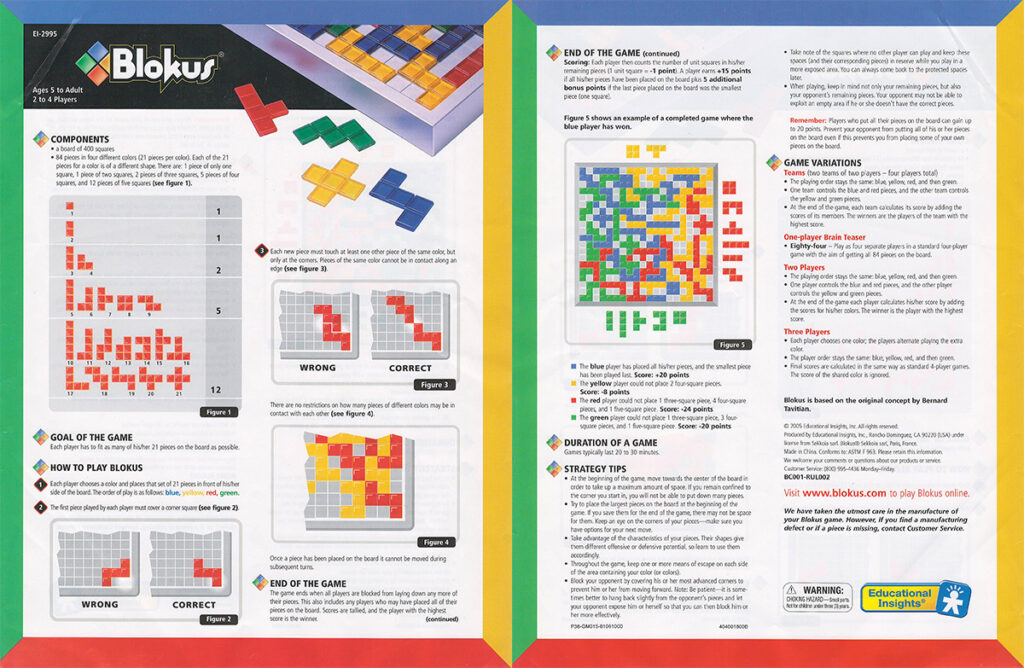
Have you ever wanted to make Tetris into a more competitive board game where you and 3 of your closest friends duke it out to see who’s the best at arranging shapes? Except your pieces can’t directly touch your other pieces. But they must touch corners with at least one of your other pieces.
Oh, and everyone is simultaneously trying to screw the other players over too?
Welcome to Blokus – the board game that promises all of the above and shenanigans to boot. Don’t just take out word for it though – you’ll get some laughs out of the cruelty we put each other through in the video below, or you can continue ahead to check out the rules.
How to Play Blokus
Player Count: 2-4
Estimated Play Time: 20-30 minutes
Blokus Rules PDF
Blokus is a game that doesn’t make you feel like you’re reading a novel while learning how to play it, making it very accessible from the start.
Setup
Each player selects a color (Red, Yellow, Blue, or Green) and collects their 21 differently shaped pieces. All players receive the same quantity and shapes of pieces, and each piece is arranged out of 1-5 smaller squares, as noted in the “Components” section of the rules.
Set out the 20×20 grid board, have each player choose a corner to begin from, and then the game can begin!
Gameplay
While Blue is officially supposed to go first, followed by Yellow, Red, and finally Green, we usually elect to roll a die instead to determine who goes first, then have play proceed clockwise around the table. Plus, when you have a metal d100 like Sir Chonkers on your shelf, you look for every opportunity to show it off.
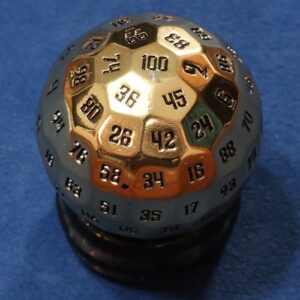
Each player’s first move begins from the corner of the board they selected. A square of one of their pieces must reside in the corner they selected for it to be considered a valid starting move. The rules even spell this out nicely with a picture.
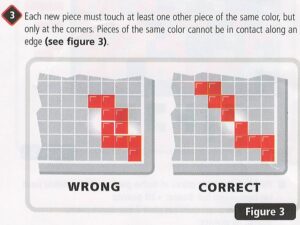
Your subsequent pieces must touch at least 1 corner of your previously placed pieces, but your opponents’ pieces are allowed to touch the sides of your pieces as much as they want. Once a piece is placed, it cannot be moved for the rest of the game.
Your goal by game’s end is simple – play as many of your pieces as possible. Gameplay proceeds until there are no valid moves left for anyone, then all players count the squares of their remaining pieces. Whoever has the fewest squares remaining (not individual pieces), is the winner!
So for example, if I have 2 pieces left, one with 5 squares and the other with 4, I have a score of 9. My opponent has 3 pieces left, two with 3 squares and one with 2, totaling 8. Despite my having fewer pieces, they have fewer squares, so they win.
As you may have noticed, the game explains this by having you add up the total of squares you played, then subtract those you still have left to get your score instead. This scoring method takes longer and is generally unnecessary, as the 15 point bonus for using your pieces is honestly spiking the ball on your victory while providing the same result.
The only exception is if you have multiple players who used all their pieces, in which case you can use the 5 point bonus for using the single square piece last as a potential tiebreaker.
Thankfully later versions of the Blokus rulebook use our method (the golf score) for scoring, but for some odd reason, keep the one in this set of rules as an advanced scoring method.
Blokus Strategy Tips
The Blokus rulebook pictured above actually does a great job laying out strategies to improve your gameplay – something that was stripped from the most recent rules PDF. Here’s a quick summary of the things you’ll want to know to stay ahead of your opponents.
Be Aggressive About Claiming Space
While this is good advice for 2 and 3 player games, it’s easier to spread out when fewer people are competing for territory within the same 20×20 board. In 4 player games, you have to be thinking of how to do this from the very first turn.
One of the best ways to do this is to sprint toward the center of the board with some of your larger pieces so you can maximize your options for spreading out. Failing to do so can result in your neighbors quickly boxing you into a quarter or less of the available board, which in turn will make it very difficult to use all your pieces.
Look For Opportunities To Secure Your Territory
Your opponents are going to be trying to claim space just like you, so finding ways to slow or prevent incursion into your territory can reduce their options or force them to use smaller pieces they’d prefer to save early in the game.
As the board starts to become more densely populated, you can often achieve this by wrapping your pieces around opposing corners. If you can’t completely seal off a corner, look at the pieces they have left and leave them space that doesn’t work well with their remaining shapes.

Save Your Small Pieces As Long As Possible
The four pieces you receive that are composed of 1, 2, or 3 blocks are extremely valuable, as they fit in small spaces that can be very difficult to close off.
Each can either help you break into someone else’s territory in a pinch, or they can be used at the end of the game to ensure you have something to do while your opponents struggle to use their remaining pieces. Squandering these tools early will almost always put you in a bind in the mid to late game.
Try To Leave Yourself Multiple Plays For Future Turns
While this is easy to do in the early game, as there are very few pieces on the board, by the time you’re 5 or 6 turns in and fighting for the center of the board, your level of skill in this area of gameplay can make or break the rest of the game. Aim to have lots of corners that can let you break out into other sections of the board.

Additionally, you’ll want to prioritize moves that use areas your opponents can play in. If you’ve managed to save a space only you can use, save it for as long as you can so you have good moves left to you toward the end of the game.
Blokus Variations
While the base game of Blokus is my favorite way to play this game, sometimes it’s fun to switch things up. For those who like a little more variety within a board game’s box, Mattel has you covered with a few gameplay variants suited for 2, 3, or 4 players.
Blokus Teams
Blue and Red work together against Yellow and Green, with the scores from both colors being combined at the end of the game. Gameplay alternates between players from each team (so Blue goes first, followed by Yellow, Red, and Green per the official rules), and the game progresses like a normal game of Blokus.
This variant can either be played with 2 players controlling 2 colors each or 4 players each controlling their own color. As with the normal gameplay above, it doesn’t really matter which colors team up or go first, so long as play alternates between teams.
One Player Brain Teaser
This is a neat solo play Blokus variant where you control all 4 colors, with the goal of trying to play all 84 pieces on the board. This is trickier than it appears at first glance, and is a great way to get a better feel for navigating the board if you’re looking to up your game between board game nights.
Three Players, Four Colors
Rather than leaving the last color in the box during a 3 player game, each player plays 1 color as normal, then when the 4th color comes up in turn order, players take turns making moves for that color.
While this allows you to mess with other players’ moves throughout the game without having to commit your own pieces, they get to return the favor if you don’t plan accordingly, simulating a 2 vs 1 environment that can be very problematic to work around as space on the board becomes scarce.
Need More Variety? Check Out These Other Blokus Games!
There are a few different Blokus games that have released since the original, each bringing something a little more specialized to the table than the original game. These are great options for catering either to specific needs or simply changing up Blokus gameplay to keep each experience fresh and interesting.
Functionally identical games like Blokus XL will be omitted from this list, as they only change the size of the board and pieces, not any aspect of gameplay.
Blokus Duo
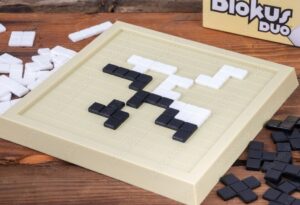
Blokus Duo is designed specifically as a 2-player Blokus experience, utilizing a 14×14 board instead of the standard 20×20. This reduces the board’s size by just over half, so you don’t have to do something more cumbersome like a team game to ensure space is at an appropriate premium.
Unfortunately, this game’s design comes with a flaw – if the 2nd player simply mimics every move and placement of the 1st, the game will result in a draw 100% of the time.
Therefore, it is recommended that you add an additional rule preventing players from playing the exact same piece as their opponent did on their last turn.
Blokus Trigon

Blokus Trigon is my favorite Blokus variant to date, swapping the square grid for a slightly larger hexagon. Players have 22 pieces instead of 21, and each is made up of smaller triangles instead of squares. Sides may not touch and corners must touch as normal, but because of the way the triangles are oriented, it can feel like a corner is touching a piece’s side!
Beyond that, scoring and gameplay is identical to the original game, so you get a completely different space to play in without having to learn a whole new game. Well worth the pickup if you’re a fan!
Blokus 3D
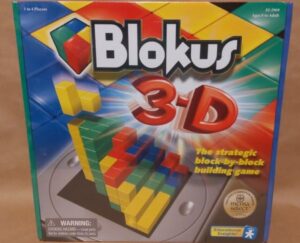
Blokus 3D does something pretty different with it’s 3D interpretation – players must take turns placing their pieces to build a specific 3D structural shape.
These pieces can only be placed from directly above the board, and a piece cannot create internal holes or tunnels that cannot be filled from directly above the board in order to be considered a legal move.
Pieces also must be placed so they touch at least 1 face of your other pieces – a big difference from normal Blokus games! When the game ends, players score 1 point for each square where their color can be seen from the top of the structure, then deduct a point for each piece they couldn’t play.
A unique experience to be sure, but not something I really consider Blokus either.
Blokus Shuffle: Uno Edition
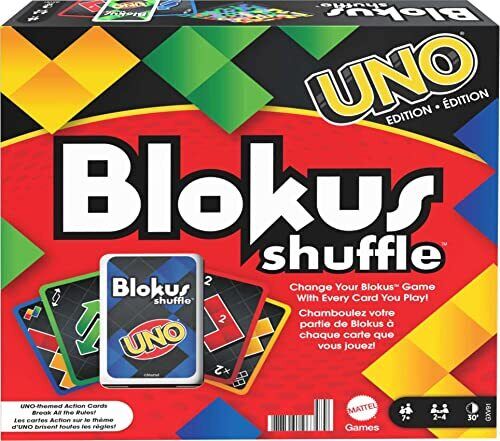
Would you like some extra chaos with your chaos? If so, Blokus Shuffle: Uno Edition is exactly what you’re looking for.
In addition to normal Blokus gameplay, each player has a 14 card deck with effects inspired by the Uno card game. You’ll start with a hand of 2 cards, and each turn you’ll play a card from your hand before playing a piece. If the card’s effect is applicable, you use it. If not, you simply discard it. Then you draw from your deck at the end of your turn.
These cards dramatically break the rules of Blokus at times, allowing you to make normally illegal moves or mess with your opponents’ pieces. Be warned though, once you’ve used all your cards, they’re gone – no reshuffling of the discard pile when the deck is empty.
All other elements of gameplay and scoring remain the same, which is fortunate as there’s already a lot to keep track of compared to any other version of Blokus!
Is Blokus A Good Game?
Blokus is a board game I’d recommend for any family who likes playing board games, especially those with younger children who are just beginning their journey into the hobby. The plastic pieces are pleasant to hold, look at, and rotate, the rules are relatively simple, and it’s good for developing spatial awareness skills.
I’d also recommend Blokus for board game groups who like having strategic board games on hand that don’t always require a ton of brainpower to get into. Games rarely exceed half an hour, so for those with shorter attention spans, you can also still sneak a game in after dinner while having time to move on to another activity with ease.
That said, Blokus is not Scythe, Lords of Waterdeep, or Twilight Imperium – nor is it meant to be. If your group prefers heavier, all-afternoon or evening games that test the limits of their strategic skills, Blokus and its many variations will probably be a safe series of games to skip.
Overall, I personal consider this a well-designed game, and it’s often a gateway game I use to show people that the board game world goes beyond Monopoly and Uno. It does a lot very well, and is a game I’m always happy to come back to when people are having trouble deciding what to play.
Other Board Game Articles You’ll Love:
- Quinto Rules and Strategies
- Splendor Nobles Guide
- Best Munchkin Expansions
- How to Play 7 Wonders
- Kingdomino vs Carcassonne
- Lords of Waterdeep Lords
Braden is a founder of Assorted Meeples and has been a gamer & writer with a vivid imagination all his life. Don’t believe us? Check out his excitement when meeting Goosebumps author R.L. Stine as a kid! An avid Magic: The Gathering spellslinger for over 15 years, you can always convince him to shuffle up for a game (or three!) of Commander.

